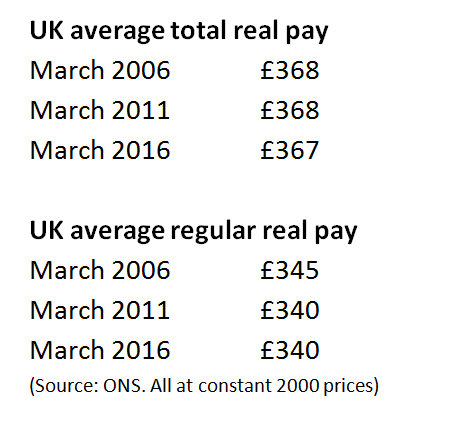And the annual March real £ wage changes from 2006 in chart form :


From the ONS table of “average weekly earnings at constant 2000 prices”, published today, we find the following March wage levels:

And the annual March real £ wage changes from 2006 in chart form :

These figures do not include the self-=employed, who form an ever larger proportion of the workforce, and whose income is likely to have increased less on average.
Nominal total average pay rose in March at an annual rate of 1.9%, while average regular pay (excluding bonuses) rose by 1.8%. Taking the annual increase over the last 3 months, total pay is up by 2%, regular pay by 2.1%. The biggest increases were in finance and business, and in construction.
In today’s suite of labour market statistics, we note that over the last Quarter (January to March, compared to October to December), the total of those in employment is up by 48,000. Of this, the number of employees is up by 28,000, while the number of self-employed rose 20,000.
Over the last year, the number of employees has risen by 255,000, and the number of self-employed by 182,000. Thus the self-employed form 42% of the total increase over the last year.
Broken down into full-time and part-time we find:
Full-time employees +201,000
Full-time self-employed +131,000
Part-time employees + 53,000
Part-time self-employed + 50,000
We can therefore see that the structure of our workforce is changing rapidly. Not only do we have one of the most deregulated labour markets in the world for employees – with the 3rd lowest employment protection, according to the OECD scoring system – but we now see an ever-increasing section of the workforce outside any system of protection.
Of course, for many being self-employed is a positive and beneficial career choice. But it seems extremely probable that for many, the status of self-employed is one as to which they had little or no choice, and which leaves them devoid of protection.
Policy Research in Macroeconomics (PRIME’s official name) is a company limited by guarantee, incorporated in England and Wales. It is company no. 07438334 and its registered office is at 11a Hatch Road, Pilgrims Hatch, Brentwood, Essex, CM15 9PU.
We collect cookies on this website through web analytics. For more information, please read our Privacy Policy.
Twitter
@Primeeconomics
@AnnPettifor
@RefractionsJs
Facebook:
Prime Economics
Linkedin:
Ann Pettifor
Jeremy Smith
jeremy.smith @ primeeconomics.org
+44 20 7723 6940
(0) 7951 032283
PRIME
51 Clarence Gate Gardens
Glentworth St
London NW1 6QS
Provided that you acknowledge the authors, that you fairly represent the views they express and that you credit primeeconomics.org (and where relevant any original source of the article in question) with due prominence, you may freely quote from articles on this website.
This website collects cookies and analytic data. To use our website you must consent.
For more information read our Privacy Policy.